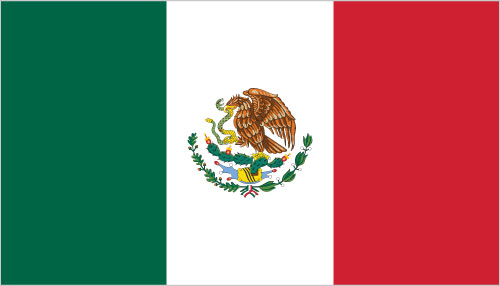Last updated on May 15th, 2022
54. Mexico’s lowest elevation point is Laguna Salada at 10 meters.
55. Mexico is one of the top soda consuming countries in the world.
56. Mexico uses four time zones.
57. Mexico is divided into three geographical regions: the northern, the central and the southern.
58. The Rio Grande is the longest river in Mexico. The river is 3033.613 km in length and is 18 m deep.
Flag of Mexico

Facts about Mexico city, cheap transport, air pollution, museums, drunk driving, tampons, colorful poultry, obesity and more
59. It is a diverse and vast city built on a lake. It is so enormous that most visitors are amazed by its size when they fly into the city at night, witnessing the ocean of twinkling lights.
60. Over the past 100 years, Mexico City has sunk over 9 meters in certain areas; in fact, it is constantly sinking. The phenomenon is due to the fact that the city is pumping water from the aquifer below the city at an alarming rate.
61. The city has several interesting nicknames including City of Hope, City of the Palaces, and Capital in Movement.
62. More than 5 million passengers use Mexico City’s Metro, which is the cheapest and largest in Latin America.
63. The city’s international airport is the busiest and largest in Latin America.
64. Interestingly, Mexico City boasts the most museums in the world, making it a cultural hub.
65. It also has more than 30 concert halls and 100 art galleries.
66. When it comes to the number of theaters, it only trails after New York, London, and Toronto.
67. Each year, residents of Naco, Mexico, join those of Naco, Arizona, for a volleyball match over the fence separating the two countries.
68. Mexico is the world’s largest producer of silver (5600 MT) followed by Peru (4100 MT) and China (3600 MT).
69. The city suffered from extreme air pollution 10 years ago. In fact, the authorities announced it as a public risk for 355 days of the year. However, steps taken by the government have reduced pollution levels tremendously.
70. In the early 2000s, an average of 478 crimes was reported daily in the city. Since then, however, there has been a huge decrease in crime rates. This is in contrast to certain parts of the country.
71. It can take three hours to drive a distance that would usually take 20 to 30 minutes in Mexico City.
72. Unlike what many people picture when they think of Mexico, cacti do not grow everywhere. In fact, it can be hard to find them in cities.
73. Anyone who wants to find the best tacos should stay away from the posh restaurants and buy from a street stall. When it comes to street food, Mexico is comparable to Asia.
74. The dress code in Mexico is quite strict. Some bus drivers wear suits.
75. In Mexico, tampons are a sensitive subject. Although most Mexicans argue that this makes them look bad, most people are either scared of them or have not heard about them.
76. It is possible to see signs in Mexican public toilets urging people to flush toilet paper rather than throwing it in the trash.
77. In Mexico, drunk drivers have it easy. It is common for the police to stop cars and ask drivers whether they have been drinking. If a driver says no, he/she is free to go.
78. There are numerous words for corn in Mexico. Peru produces more than 55 varieties of corn in a wild range of colors.
79. Torreon, a Mexican City, imposed fines for shaving with an electric razor or putting on make–up while driving.
80. People can purchase colorful poultry in Mexico.
About Mexican sports
81. Mexican sports range from the ordinary sports to others that most people in other countries have never heard of. In fact, the diversity of sports within the country is as rich as the culture.
82. The national sport in the country is called Charreira, which displays distinctive horsemanship techniques.
83. Futbol, or soccer, is one of the most popular sports in Mexico.
84. Mexican bullfighting, also called fiesta brava, is similar to the Spanish version. It has been popular for around 400 years.
85. Mexican professional wrestling, called lucha libre, is very popular. It involves rapid action, a succession of holds, and impressive high–flying moves that astound the audience.
86. Mexico holds second place to the United States in the number of boxing world titles won.
87. Mexico hosted the FIFA Football World Cup twice; in 1970 and 1986.
88. Sports such as golf, basketball, and baseball are widely watched in Mexico due to influence from the US.
89. There are excellent surfing sports in Mexico, such as Playa del Carmen, Cancun, Tulum, and others.
90. Mexico hosted the world championships of the traditional sport of Basque Pelota in 1982, 98, and 2006. This is a name given for several sports played with ball using a racket, one’s hand, against a wall, or a wooden bat.
Fun/amazing/weird facts about Mexico
91. Mexican tamale weighs around 150 pounds and is 3 feet long.
92. The country introduced corn, chilies, and chocolate to the world.
93. It is home to a rare breed of rabbit, which usually lives near volcanoes.

94. The earliest printing press in North America was used in 1539 in Mexico City.
95. The oldest university in North America, the National University of Mexico, was established in 1551. It was founded by Charles V of Spain.
96. Mexican kids rarely receive gifts on Christmas day.
97. Mexico is located in one of the most violent volcano and earthquake zones on earth. The country is a part of the circum-Pacific “Ring of Fire”—a region of active volcanism and frequent seismic activity.
98. Mexico City was built over the ruins of Tenochtitlan, a great Aztec city built on a lake.

99. The Chihuahua, named after a Mexican city, is the smallest dog in the world.
100. The first great Mexican civilization, the Olmecs, build numerous cities and curved great colossal heads around 1400 to 300 B.C.
101. The Caesar salad was invented in Mexico by Caesar Cardini, an Italian-American restaurateur, and chef.
Quick facts on drug trafficking in Mexico
Mexico – country at a glance
| Independence | 16 September 1810 (declared); 27 September 1821 (recognized by Spain) |
|---|---|
| Capital City | Mexico City (19°26′N 99°08′W) |
| Largest City | Mexico City (19°26′N 99°08′W) |
| Total area | 1,964,375 sq km |
| Population | 130,739,927 (2024 est.) |
| Official Language | Spanish |
| Demonym | Mexican |
| Literacy rate | total population: 95.2% (2020) |
| Suffrage | 18 years of age; universal and compulsory |
| Location | North America, bordering the Caribbean Sea and the Gulf of Mexico, between Belize and the United States and bordering the North Pacific Ocean, between Guatemala and the United States |
| Borders | United States, Belize and Guatemala |
| Land boundary | total: 4,389 km |
| Coastline | 9,330 km |
| Currency | Peso (MXN) |
| Religion | Roman Catholic |
| Government type | federal presidential republic |
| President | Andrés Manuel López Obrador |
| Life expectancy at birth | 74.6 years (2024 est.) Life expectancy at birth indicates the number of years a newborn infant would live if prevailing patterns of mortality at the time of its birth were to stay the same throughout its life. |
| Climate | varies from tropical to desert |
| Terrain | high, rugged mountains; low coastal plains; high plateaus; desert |
| Mean elevation | 1,111 m |
| Lowest point | Laguna Salada -10 m |
| Highest point | Volcan Pico de Orizaba 5,636 m |
| Literacy rate | 95.2% |
| Natural resources | petroleum, silver, copper, gold, lead, zinc, natural gas, timber |
| Agricultural land | 54.9% |
| Birth rate | 14.3 births/1,000 population (2024 est.) |
| Death rate | 6.5 deaths/1,000 population (2024 est.) |
| Sex ratio | 0.96 male(s)/female (2024 est.) |
| National symbol | golden eagle |
| National anthem | "Himno Nacional Mexicano" (National Anthem of Mexico) |
| National colors | green, white, red |
| Industries | food and beverages, tobacco, chemicals, iron and steel, petroleum, mining, textiles, clothing, motor vehicles, consumer durables, tourism |
| Exports | $649.312 billion (2023 est.) manufactured goods, oil and oil products, silver, fruits, vegetables, coffee, cotton |
| Imports | $673.828 billion (2023 est.) metalworking machines, steel mill products, agricultural machinery, electrical equipment, automobile parts for assembly and repair, aircraft, aircraft parts |
| GDP - per capita (PPP) | $22,400 (2023 est.) |
| Time Zone | (UTC−8 to −5) |
| Internet country code | .mx |
| Calling Code | +52 |
| Drives on the | Right |
| Table last updated | August 15, 2024 |
